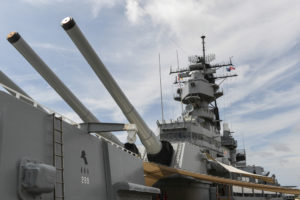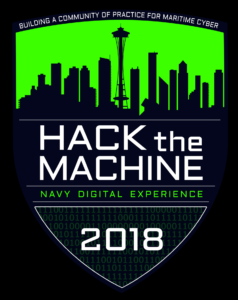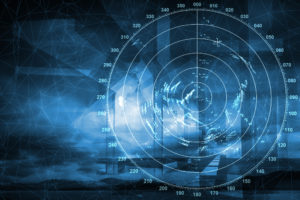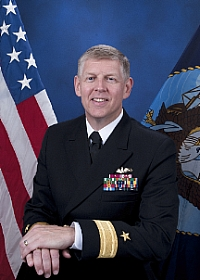
From Big Guns to Big Data: US Navy Looks to Tech for Advantages

(Felix Lipov/Shutterstock)
For decades, the US Navy’s measure of success was its capability to hit a moving target at sea better than the other guy. But today, the $142-billion organization considers its ability to innovate with big data and AI as key aspects of its mission, and those capabilities will be the central theme of its HACKtheMACHINE event this weekend in Seattle, Washington.
“We’re on what I would call a digital engineering journey in the Navy,” says Rear Admiral Lorin Selby, who is the Navy’s chief engineer and the Naval Sea Systems Command (NAVSEA) deputy commander for Ship Design, Integration, and Naval Engineering. “We’ve been on this for a while now, but we’re starting to actually get some traction.”
Increasingly, emerging technologies like big data analytics and AI — as well as DevOps software methodologies in general – are playing crucial roles in the Navy’s capability to accomplish its mission. Technology today touches all aspects of what the Navy does, from maintaining equipment on ships and optimizing supplier logistics, to autonomous navigation and improving the accuracy of weapons.
That new technological focus has been a relatively recent shift, according to Admiral Selby, who spoke to Datanami today before the start of HACKtheMACHINE in Seattle.
“From World War II to the end of last century, if you think about what made a navy great, what made a navy dominant on the high seas, it was really the ability to bring a large number of vessels with large amounts of firepower and quite frankly, bigger guns with longer range and better accuracy,” he says. “If you could that, you could pretty much carry the day, win the battle, control the seas.
“That calculus has changed this century,” Admiral Selby continues. “If you look at our ships today, the majority of our sensors and weapons system, and even the ships themselves – the things to control the turbines, the generators, the shafts – all those system are controlled by software. And that software is really what provides the capability to the US Navy…So software is really where it’s at today. And if you can find a way to be more agile – deliver software more quickly and more reliability, I think you can win the day.”
HACKtheMACHINE plays several roles in the Navy’s pursuit of software and AI excellence. For starters, it serves as a sort of recruiting tool for data scientist and other computer enthusiasts who might not consider careers in the Navy, or even jobs with defense contractors like Booz Allen Hamilton that build many of the Navy’s systems.
“One of the earlier drivers for doing this was the people we want for serving the country at the keyboard don’t go to airshows,” says Zac Staples, founder and CEO of Fathom Five, the company that puts on HACKtheMachine, and a former director of the NPS Center for Cyber Warfare at the Naval Post Graduate School. “Most people think the Navy is pushups and underway time. This is an opportunity to show people that we’re collecting satellite data, we’re collecting machinery data. We have the largest terabyte data store off of new Zumwalt destroyer than just about any industrial control system out there.”
‘Blue Angels for Geeks’
This weekend’s HACKtheMACHINE event (codename: “Blue Angels for Geeks”) has three tracks with three different types of data problems, including:
Capture the Flag
Track one is a maritime version of Capture the Flag that encourages hackers to try and infiltrate the Navy’s maritime gear to steal signals, override the autopilot, send false messages, and other tricks that cyber ne’er-do-wells could try. This track exposes participants to a realistic Navy system called TRUDI which is close to (but not exactly like) the electronics gear that the Navy actually uses.
“It’s not exactly configured how a Navy ship is built,” Staples says, “[but] it allows us to gain insight into what might be possible in maritime infrastructure and then tie those insights back to the specification that Admiral Selby writes on how we’re going to build ships now in to the future.”
Data Science and the Seven Seas
In track two, data enthusiasts get exposed to a large real-world data set, called the Automatic Identification System (AIS), that tracks ship movements through time and space, with the goal of devising better ways to keep ships from colliding at sea. The Navy has suffered a series of unfortunate events while under-way, so this is not an academic exercise.
Participants will be given a collection of Python, R, and ArcGIS tools to work with, or they can bring their own data science tools. The Navy is interested in developing new models that describe the interaction of ships at sea, which it can use to bolster the navigation rules (or COLREGS) that ships follow to avoid collisions. The challenge here is that ship interactions at sea can be very dynamic, and there aren’t always COLREGS that tell a ship what to do, such as convergence of three ships to one point.
Hack for the Oceans
The third track is designed to highlight better technologies and techniques for developing and maintaining advanced software systems in an edge environment. This exercise simulates an emergency event that a Navy ship might respond to, like the aftermath of a major hurricane, and calls on particpants to devise better ways to ensure networks are connected, servers are available, and data services are on-lie.
“Every single one of our ships and submarines and aircraft carriers has an on-premises stack of server infrastructure,” Staples says. “Our program manager has created a platform as a service infrastructure called CANES. So we built a representation of CANES in the cloud and we’re doing the first ever application development challenge on that and the results of this will directly feed the developer guide for people who are going to be able to build software that’s designed on our ships and submarines across everything from logistics, manpower, and mechanical systems support.”
Fresh Legs
The Navy has a multitude of guidelines that dictate how things are supposed to work. With HACKtheMACHINE, the Navy is basically putting those guidelines on hold and seeing how other people would tackle the challenges that it faces, with an eye on using innovative big data technology to address them.
“What we’re really trying to do here is open a doorway to, first off, inform other folks who are not familiar with the military or the US Navy what we do, what our mission sets are, and what our problems are,” says Admiral Selby. “Because quite frankly, we’ve got some pretty cool problems. We’re looking for some smart folks who may not think like we do, who aren’t tainted by our years of experience and doing thing the way we’ve always done them. We’re trying to get some new ideas on the table here.”
The Navy will always require sailors to do the grunt work of supporting the ships and aircraft on land and at sea. But like every large organizations these days, it also realizes that real efficiencies can be gained, not just on the logistics and operational side of the mission, but on the warfighting part too. That’s where big data can play a big role.
“We have a long way to go but we have been looking at big data for a while now,” says Admiral Selby, who has a nuclear engineering degree from MIT. “We’re finding that by using different algorithms, we can prevent or see a failure before it happens and then do things to avert or prevent it.”
One of the Navy’s big data project called condition-based maintenance has the potential to pay huge dividends to the taxpayer-funded service. Instead of doing maintenance on a set schedule, such as every six or eight months, the Navy can apply algorithms against sensor data to determine the best time to perform maintenance.
“Now we’re able to take the actual data from every individual component and assess it and make a determination for that individual pump or motor or valve on any given ship on when it needs to be serviced,” Admiral Selby says. “That’s going to drastically change the way we do our maintenance, and I think it will actually extend the lives of our ships and optimize the way we operate them and keep them at sea.”
The sharp end of the Navy’s stick is also getting sharper, thanks to algorithms that can more efficiently sort the signal from the noise in sensor data from sonar, radar, and visual data, and help the human operator make a better decision. “A human is going to have to have, at least for the presumable future, a vote in this thing, but the machines will be able to inform the operators and assist us in making decisions,” Admiral Selby says.
AI is already being used to some degree with autonomous vehicles, including unmanned aircraft and submarines. Eventually, though, AI could find its way into the navigational heads of weapons systems, too, but we’re not there yet. “Think through how a torpedo or missile could have some kind of AI in it to help it discriminate,” Admiral Selby says. “That starts to get a little fuzzier when you get into ethics and control of weapons and that kind of thing. I would say that’s not the first substantiation of where we go, but it’s carinal a logical outcome of what we’re talking about.”
Related Items:
Navy Launches Big Data ‘Ecosystem’ Effort
Ex-Security Chief Dishes on Israel’s Big Data Ops

































